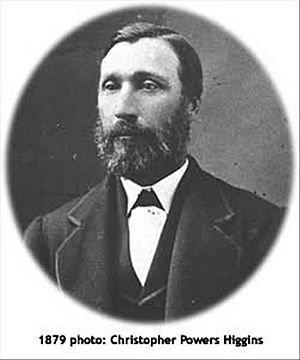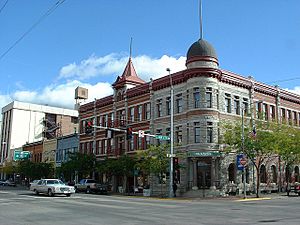Christopher P. Higgins facts for kids
Christopher Powers Higgins (born March 16, 1830 – died October 14, 1889) was an important American Army captain and businessman. He helped start the Hellgate Trading Post and the city of Missoula, Montana with his partner, Frank Worden.
Higgins built some of the first sawmills and flour mills on the Clark Fork River near what is now Downtown Missoula. He also helped build many of Missoula's first buildings. He was one of the first county commissioners and a member of the first government of the Montana Territory. He also helped create The Montana Historical Society. Today, Higgins Avenue, the Higgins bridge, and the Higgins Block building in Downtown Missoula are named after him. He is buried in Missoula Cemetery.
Contents
Early Life and Western Adventures
Christopher P. Higgins was born in Ireland on March 16, 1830. He moved to the United States in 1848. He immediately went to the western frontier, which was the undeveloped land in the western part of the country. There, he joined the army.
In 1853, he joined Washington Territory Governor Isaac Stevens. He also worked with Lieut. John Mullan, who was a famous road builder. Higgins became a wagon master for their survey trip. This trip explored the Bitterroot and Missoula Valleys. They were looking for the best path to build a railroad. The railroad would connect the Mississippi River to the Pacific Ocean.
Governor Stevens also worked with Native American tribes. He signed the Hellgate treaty with the Bitterroot Salish, Pend d'Oreilles, and Kutenai tribes. This treaty allowed safe travel through their lands. Higgins was a witness to this important agreement.
Founding Missoula: A New Beginning
In 1860, Higgins teamed up with Frank Worden. Worden owned a general store in Walla Walla, Washington. Together, they decided to open the Hellgate Trading Post. This post was in the Missoula Valley, right along the new Mullan Road. The Mullan Road had just reached the area that summer.
On March 30, 1863, Higgins married Juliet P. Grant. Her father, Richard Grant, was another early settler in Missoula. Grant Creek is named after him.
The Hellgate Trading Post never grew very large. This was because the water supply wasn't good enough to power the mills Higgins and Worden wanted to build. So, in 1865, the settlement moved four miles east. This new spot is where Downtown Missoula is today. They renamed it Missoula Mills.
In 1873, Higgins started the Missoula National Bank. It was one of the first banks in the Montana Territory. He placed it next to the Worden & Company Store, which he and Worden had built two years earlier. The store itself was built where Higgins' first log home used to be. He later built a bigger home a few blocks away. In 1888, Higgins began building the Higgins Block. Sadly, he died before it opened in 1889. Today, this historic building is listed on the National Register of Historic Places.
Business Rivalry: Higgins vs. Hammond
Andrew B. Hammond arrived in Missoula in 1872. Within four years, he became a major owner of Eddy, Hammond and Company. This company later became the Missoula Mercantile in 1885. It quickly became the biggest store in western Montana, taking the lead from Worden and Company.
When the Northern Pacific Railroad was being built towards Missoula, both Higgins and Hammond wanted the railroad to stop in their city. Higgins and Worden offered prime land to the railroad company. They hoped to get the railroad to stop there and also win the contract for lumber. This lumber was needed for railroad ties, bridges, and buildings. Missoula did get the railroad stop, but Eddy, Hammond and Company won the big lumber contract.
In 1881, Hammond started buying shares in Higgins' Missoula National Bank. By 1888, Higgins was forced out of his own bank. The bank's name was changed to First National Bank of Missoula. The competition between Higgins and Hammond lasted until Higgins' death in 1889. The rivalry even continued with their families.
C. P. Higgins' son, Frank G. Higgins, became mayor of Missoula in 1892, even though Hammond opposed him. Two years later, when the Higgins Avenue Bridge needed to be replaced, there was a debate. Some wanted the bridge to go straight across, north-to-south. Others, including the Higgins family, wanted it to go diagonally towards the Bitterroot. When it came to a vote, the Higgins family's idea won.
Higgins' Lasting Legacy
Higgins' name lives on in Missoula. Both Higgins Avenue and the Higgins Avenue Bridge are named after him. This bridge is considered the numeric center of Missoula.
In 1893, land was given to the city to build the University of Montana. The streets on this land were named after Higgins' seven children. These children were Francis, Maurice, Arthur, Helen, Hilda, Ronald, and Gerald. Interestingly, the street now called Gerald Avenue was once named Hammond Avenue, after Andrew Hammond.



